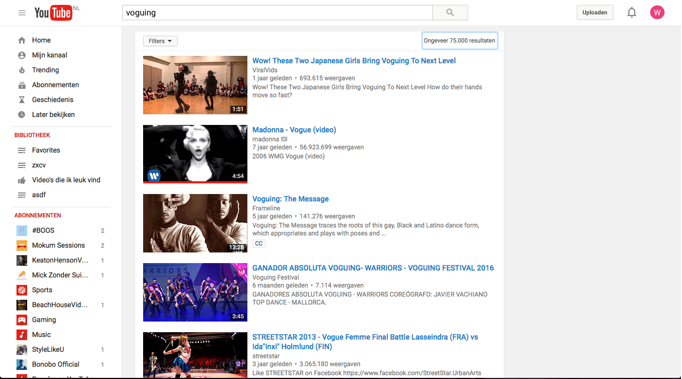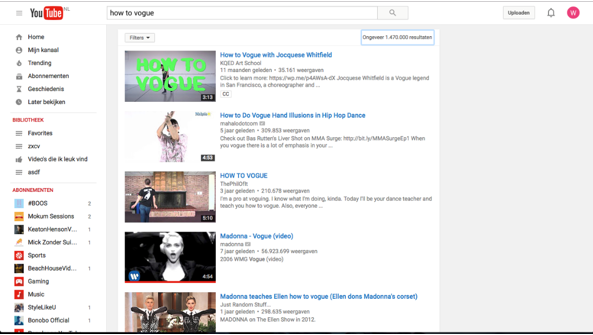
How voguing spread around the world
In the process of voguing becoming a worldwide phenomenon, Madonna’s song "Vogue" and the documentary Paris Is Burning in the ‘90s were very influential. Additionally, and more recently, the role of social media in sharing and getting things known to a larger community has been impactful and progressive.
Madonna’s music video Vogue and the documentary Paris Is Burning
In spring 1990, Madonna’s single "Vogue" was released. For this song's music video, she recruited Jose and Luis Xtravaganza from the House of Ninja. They injected the real dancing into Madonna’s performances (Monaghan, 2006). Before the release of her song, most people never heard of voguing. But that changed when her song became a worldwide hit. The vogue scene was already on its way to Europe, but with these developments, it got a huge boost (Monaghan, 2006). In her video clip, you can see people voguing while she’s singing: “Come on, vogue. Let your body move to the music” and “it makes no difference if you're black or white, if you're a boy or a girl”. With the video and the lyrics, people could begin to understand what voguing was all about.
'Come on, vogue. Let your body move to the music.'
In December 1990, the documentary Paris Is Burning by Jennie Livingston debuted. The film shows the ballroom culture and its competitions in New York. Few documentaries can claim to have sparked as much of a discussion and controversy as this one (Clark, 2015). In 1991, the film won the grand jury prize at the Sundance film festival. It later went on to commercial success after being picked up for distribution by Miramax (Clark, 2015).
America’s Best Dance Crew
In 2009 the dance group Vogue Evolution participated in America’s Best Dance Crew (ABDC) on MTV. The dance group was formed in 2008 with the aim of bringing vogue and house/ballroom culture to the masses (GLAAD, 2009). In an interview with OUT Magazine, Vogue Evolution was asked why they thought it was important to bring the ballroom scene into the mainstream. Group member, Pony, answers:
"That it gets recognized, that it is hip-hop. Ballroom is hip-hop, ballroom is pop. It’s just like nobody knows. That’s the thing -- nobody knows that ballroom is all these different things and how it’s affected videos and artists and models and the runway. We’re really far out there, you know what I’m saying? The only thing is that we don’t get recognition for it. They push us to the back burner when we should be on the forefront.’’ (Anderson, 2009).
With ABDC being aired in more than 20 countries, voguing quickly became known and very popular amongst the youth.
Social media
Nowadays social media plays a big part in our lives. We check it every day to stay connected to the world and to keep track of family, friends and everyone else we want to follow. Through social media, we can know what is happening all around the world, every minute of the day. Posts, photos and videos can go viral all over the internet in a very short time. For example, not everyone watches America’s Best Dance Crew, and so not everyone would know about Vogue Evolution. But when someone shares a video of them, it can go global for everyone to see. Eventually more people know what Vogue Evolution is, without watching ABDC and hearing it from their surroundings. Hence, social media is a great way for something (like the vogue scene) to become known by many people. Events like vogue competitions can easily be shared on Facebook which leads to more visitors and more awareness.
On YouTube, people can upload videos about voguing for the public to watch. When you search ‘’voguing’’ on YouTube you get about 75,000 results. And there are almost 1.5 million videos about how to vogue. There are also interviews and documentaries related to the dance. The video channel is a great way to access everything you want to know about the ballroom scene.

Figure 4: Voguing on YouTube.

Figure 5: How to Vogue on YouTube.
Tolerance towards LGBTQ
Same-sex marriage has only been legal in all states of America since 2015, but people have become more tolerant towards lesbians, gays, bisexuals, transgenders and queers (Kuyper, Iedema, & Keuzenkamp, 2013). Because of these changes, voguing doesn’t have to be underground and secret anymore. "Voguing has returned to the mainstream, helped by New York’s swelling LGBT rap scene (aided in no small part by rapper and Harlem’s own Azealia Banks), the internet, and a generation that is becoming more active and positively effective on the community by the day.’’ (Buzzfeed, 2015)
Leiomy Maldonado, a 28-year-old transgender said to Buzzfeed: “I believe voguing is still important to the scene because it’s still an outlet for self expression and emotion. Now that it’s become a dance style inspiring many around the world, the LGBT community is being recognized for something positive.” (Buzzfeed, 2015)
Because of globalization and social media, voguing became known all around the world and became a global phenomenon. Without the worldwide web and television, this could not have happened and the Ballroom Scene would still be underground, only known by its participants. Thanks to television and the Internet, people in different countries can watch Paris Is Burning, Madonna’s music video to her song "Vogue" and clips of Vogue Evolution on America’s Best Dance Crew. Furthermore, people have been able to share a plethora of information about voguing, such as videos, photos and events.
Voguing as a global phenomenon
Voguing started as a part of the ballroom culture in a closed, underground LGBTQ-community in Harlem, New York in the 1980s. Voguing is seen as an expression of self-confidence. It first gained popularity when the dance appeared in the documentary Paris Is Burning. At that point, voguing and its culture were still very much intertwined. Starting with Madonna’s song "Vogue", celebrities started using the dance separately from the ballroom culture, which made it more accessible for a broader public. It disconnected from the LGBTQ-community and thus became part of popular culture. Popular media, especially social media, helped in the spread of voguing as a mainstream dance style. We nowadays live in a network society where a cultural phenomenon of a specific area and time gains popularity through the internet. This is the perfect example of a culturescape (Appadurai, 1990), where a piece of local culture became a global phenomenon.
References
Appadurai, A. (1996). Modernity at large: cultural dimensions of globalization. University of Minnesota Press.
Anderson, P. (2009, August 20). Vogue Evolution Strikes A Pose. Retrieved November 7, 2016, from OUT Magazine.
Buzzfeed. (2015, June 8). Voguing Is Back: This Is Why You Should Care. Retrieved November 28, 2016, from Buzzfeed.
Clark, A. (2015, June 24). Burning down the house: why the debate over Paris is Burning rages on. Retrieved November 26, 2016, from The Guardian.
GLAAD. (2009, August 17). Vogue Evolution Continues to Shine on America's Best Dance Crew. Retrieved November 7, 2016, from GLAAD.
Monaghan, T. (2006, September 13). Willi Ninja. Retrieved November 28, 2016, from The Guardian.